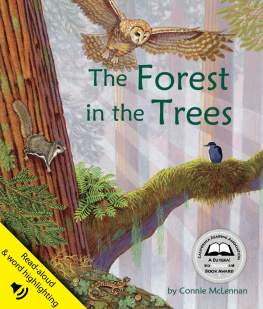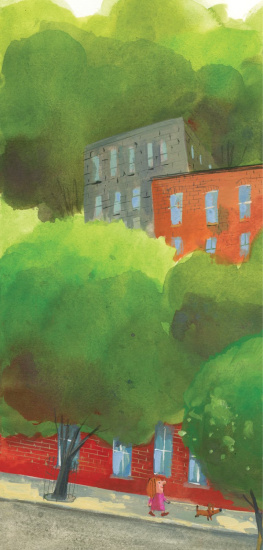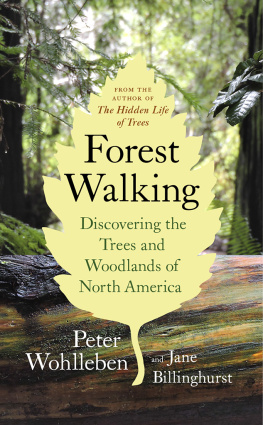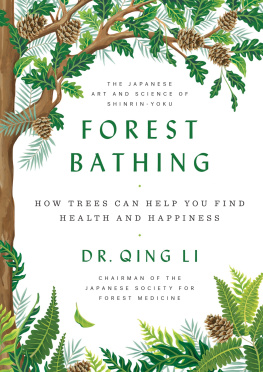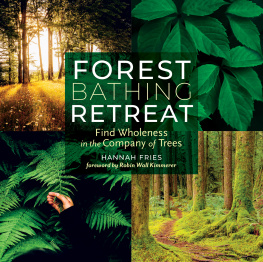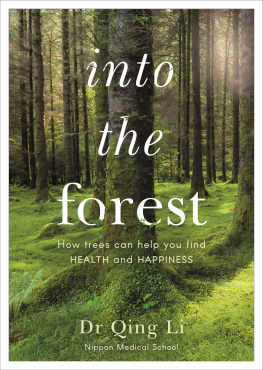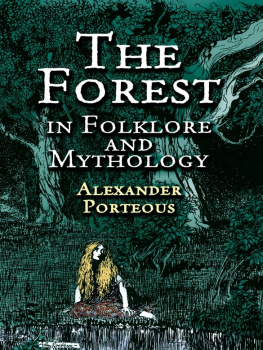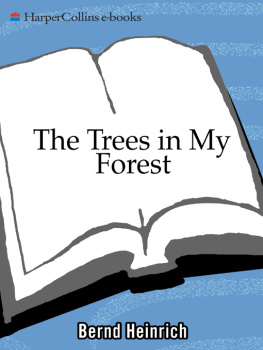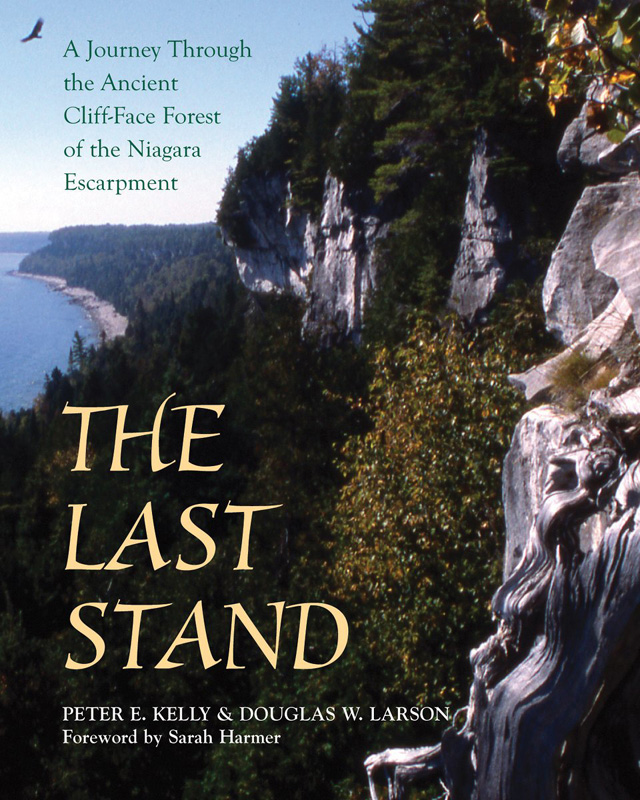THE LAST STAND
A Journey Through the Ancient Cliff-Face Forest of the Niagara Escarpment
Peter E. Kelly & Douglas W. Larson
Foreword by Sarah Harmer

NATURAL HERITAGE BOOKS A MEMBER OF THE DUNDURN GROUP TORONTO
Copyright 2007 Peter E. Kelly & Douglas W. Larson
All rights reserved. No part of this publication may be reproduced, stored in a retrieval system, or transmitted in any form or by any means, electronic, mechanic, photocopying or otherwise (except for brief passages for purposes of review) without the prior permission of Dundurn Press. Permission to photocopy should be requested from Access Copyright.
Published by Natural Heritage Books
A Member of The Dundurn Group
3 Church Street, Suite 500
Toronto, Ontario, M5E 1M2, Canada
www.dundurn.com
Library and Archives Canada Cataloguing in Publication
Kelly, Peter E., 1963
The last stand : a journey through the ancient cliff-face forest of the Niagara Escarpment / Peter E, Kelly & Douglas W. Larson; foreword by Sarah Harmer.
Includes bibliographical references and index.
ISBN 978-1-897045-19-0
1. Thuja occidentalisNiagara Escarpment. 2. Thuja occidentalisOntario. 3. Cliff ecologyNiagara Escarpment. 4. Old-growth forestsNiagara Escarpment. 5. Forest ecologyNiagara Escarpment. 6. Niagara Escarpment. I. Larson, Douglas W. (Douglas William), 1949- II. Title.
OH106.2.O5K44 2007 585 .4 C2006-906051-7
1 2 3 4 5 11 10 09 08 07
All photographs and b&w sketches are by Peter Kelly unless otherwise indicated.
Front cover: A vulture soars above the cliffs at Smokey Head, on the eastern shore of the Bruce Peninsula. Back cover: A view of Hamilton from the Escarpment.
Cover and text design by Sari Naworynski
Edited by Jane Gibson
Printed and bound in Canada by Friesens
Printed on Garda Art Silk
Care has been taken to trace the ownership of copyright material used in this book. The author and the publisher welcome any information enabling them to rectify any references or credits in subsequent editions.
J. Kirk Howard, President

We acknowledge the support of the Canada Council for the Arts and the Ontario Arts Council for our publishing program. We also acknowledge the financial support of the Government of Canada through the Book Publishing Industry Development Program and The Association for the Export of Canadian Books and the Government of Canada through the Ontario Book Publishers Tax Credit Program and the Ontario Media Development Corporation.
For Dad and David who always supported what Ive done, even if it meant hanging off cliffs for months on end (PK), and for Nick, Nathan, and Gin may you learn from the trees and grow old slowly (DWL).
TABLE OF CONTENTS
ACKNOWLEDGEMENTS
We would like to gratefully acknowledge the following agencies who provided support for our research on the eastern white cedar forests of the Niagara Escarpment over the years: the Bruce Trail Association, the Coalition on the Niagara Escarpment (CONE), the EJLB Foundation, the Escarpment Biosphere Conservancy, Global Forest, the McLean Foundation, the Natural Sciences and Engineering Research Council of Canada, the Nature Conservancy of Canada, the Ontario Heritage Foundation, the Ontario Ministry of the Environment, Ontario Parks, Parks Canada, The Richard Ivey Foundation and Swish Maintenance Ltd. We would particularly like to thank Reese Halter from Global Forest for his enthusiasm and encouragement for both our research and the book, and Marvi Ricker and The Richard Ivey Foundation who gave us the funds to get the Niagara Escarpment Ancient Tree Atlas Project off the ground. Both sponsors stepped up at a time when financial support for ecological research in Ontario had evaporated. We would also like to thank the landowners who have graciously allowed us access to the Niagara Escarpment cliff faces that cross their properties, namely Sandy Stuart, Jeff and Nancy Bettridge, Margaret Dodgson, Parks Canada, Ontario Parks, Ministry of Natural Resources, Niagara Peninsula Conservation Authority, Niagara Parks Commission, Brock University, City of St. Catharines, Bruce Trail Association, Hamilton Region Conservation Authority, Royal Botanical Gardens, Halton Region Conservation Authority, Milton Limestone and Grey Sauble Conservation Authority. If we couldnt have access to the cliffs, we could never have made our discoveries and we definitely could not have put this book together.
Many of the historical photos and references were located with the help of staff at various archives and libraries. These would include Shannon McFadyen at the Niagara Escarpment Commission, Elysia DeLaurentis at the Wellington County Museum and Archives, Linda Twitchell at the Halton Region Museum and Archives and Ann-Marie Collins at the Bruce County Museum and Archives. The Metropolitan Toronto Reference Library, Burlington Public Library, Grey County Archives and the Archives of Ontario were also valuable sources of both photos and information.
FOREWORD
by Sarah Harmer
Find yourself alone in calm woods, leaves drifting to forest floor, creeks running downhill under fallen tree bridges, and leave your footprints in the mud. Let yourself be inspired by a place that continues to breathe after you leave. Up here on the Niagara Escarpment systems are ancient. Water springs from the cavernous rock and forests grow old. Ponds are full of memory and team with fish, frogs and spotted newts. Hawks and owls, herons and salamanders all find their niche among the wetlands and woods, and through fertile fields coyote and deer secure food and safe passage.
This is where I grew up. An outcrop of the Niagara Escarpment in Burlington, Ontario. A place called Mount Nemo. The cliffs of Mount Nemo hold some of North Americas oldest living trees and over the centuries countless humans have gazed from its sheer heights across rich panoramas.
Imagine the past in this place, pullovers of Time layered in familiar yarns and colours. Four hundred years ago, in the early 1600s the Native Peoples who lived atop Mount Nemo were called the Attawandaron. Their lack of involvement in the fur-trading wars between neighbouring Huron and Iroquois tribes led the French explorers to call them Les Neutral. The Attawandaron (Neutral) First Nation lived on Mount Nemo in longhouses that were organized by the female family line, grew corn, beans and squash, and valued the fruits of the butternut and walnut trees. They were not accomplished on the water and so chose high places to establish settlements so they could look out across Lake Ontario in search of approaching canoes. In 35 years of living here my family and I had never heard of these Native people, let alone known that theyd once lived in the backfields. Delving further we learned of Jikonsaseh, the Neutral Peace Queen who travelled with Hiawatha, spreading the word of the Peace Maker and working to establish peace between warring nations.
I learned about this 4oo-year-old Attawandaron (Neutral) settlement through an archaeological dig that was undertaken as part of a recent quarry application that proposes to rezone roughly two hundred acres atop Mount Nemo from Escarpment Rural Land to Mineral Extraction Land for a below-water-table extraction operation.
In this glorious book, as they describe the geology and formation of the Niagara Escarpment, authors Peter Kelly and Doug Larson write, In the short term the Niagara Escarpment isnt going any-where. Unfortunately, huge amounts of the Escarpment are getting hauled away, five days a week, from sun-up to sundown. Gravel trucks climb to the top of the escarpment brow and descend with full loads of ancient seabed limestone crushed into gravel. The ancient ecosystems on top on this rock and the rock itself are removed forever.


